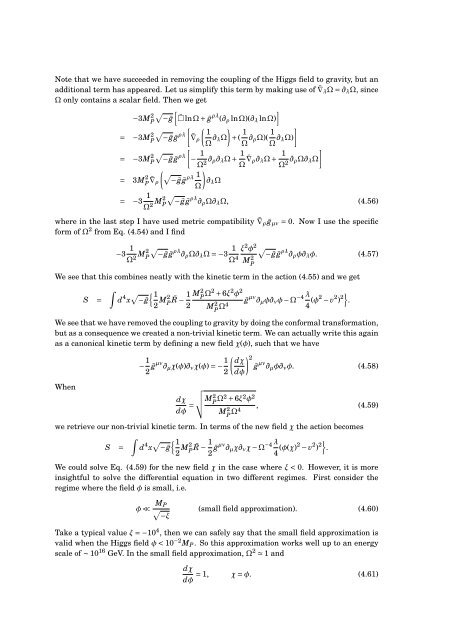Master's Thesis in Theoretical Physics - Universiteit Utrecht
Master's Thesis in Theoretical Physics - Universiteit Utrecht
Master's Thesis in Theoretical Physics - Universiteit Utrecht
Create successful ePaper yourself
Turn your PDF publications into a flip-book with our unique Google optimized e-Paper software.
Note that we have succeeded <strong>in</strong> remov<strong>in</strong>g the coupl<strong>in</strong>g of the Higgs field to gravity, but anadditional term has appeared. Let us simplify this term by mak<strong>in</strong>g use of ¯∇ λ Ω = ∂ λ Ω, s<strong>in</strong>ceΩ only conta<strong>in</strong>s a scalar field. Then we get[ ]−3MP√ 2 −ḡ ¯□lnΩ + ḡ ρλ (∂ ρ lnΩ)(∂ λ lnΩ)[ ( )= −3M 2 √P −ḡḡρλ 1¯∇ ρΩ ∂ λΩ + ( 1 Ω ∂ ρΩ)( 1 ]Ω ∂ λΩ)[= −3M 2 √P −ḡḡρλ− 1 Ω 2 ∂ ρ∂ λ Ω + 1 Ω ¯∇ ρ ∂ λ Ω + 1 ]Ω 2 ∂ ρΩ∂ λ Ω( √−ḡḡ= 3M 2 ¯∇ ρλ 1 )P ρ ∂ λ ΩΩ= −3 1 Ω 2 M2 P√−ḡḡ ρλ ∂ ρ Ω∂ λ Ω, (4.56)where <strong>in</strong> the last step I have used metric compatibility ¯∇ ρ ḡ µν = 0. Now I use the specificform of Ω 2 from Eq. (4.54) and I f<strong>in</strong>d−3 1 Ω 2 M2 P√−ḡḡ ρλ ∂ ρ Ω∂ λ Ω = −3 1 ξ 2 φ 2 √−ḡḡ ρλΩ 4 ∂ ρ φ∂ λ φ. (4.57)We see that this comb<strong>in</strong>es neatly with the k<strong>in</strong>etic term <strong>in</strong> the action (4.55) and we getS =∫d 4 x √ { 1−ḡ2 M2 ¯R P− 1 M 2 P Ω2 + 6ξ 2 φ 22 M 2 ḡ µν ∂ µ φ∂ ν φ − Ω −4 λP Ω4 4 (φ2 − v 2 ) 2} .We see that we have removed the coupl<strong>in</strong>g to gravity by do<strong>in</strong>g the conformal transformation,but as a consequence we created a non-trivial k<strong>in</strong>etic term. We can actually write this aga<strong>in</strong>as a canonical k<strong>in</strong>etic term by def<strong>in</strong><strong>in</strong>g a new field χ(φ), such that we haveM 2 P( ) dχ 2ḡ µν ∂ µ φ∂ ν φ. (4.58)− 1 2 ḡµν ∂ µ χ(φ)∂ ν χ(φ) = − 1 2dφWhen√ √√√dχdφ = M 2 P Ω2 + 6ξ 2 φ 2M 2 , (4.59)P Ω4we retrieve our non-trivial k<strong>in</strong>etic term. In terms of the new field χ the action becomes∫S = d 4 x √ 1−ḡ{2 M2 ¯R P− 1 2 ḡµν ∂ µ χ∂ ν χ − Ω −4 λ 4 (φ(χ)2 − v 2 ) 2} .We could solve Eq. (4.59) for the new field χ <strong>in</strong> the case where ξ < 0. However, it is more<strong>in</strong>sightful to solve the differential equation <strong>in</strong> two different regimes. First consider theregime where the field φ is small, i.e.φ ≪ M P√−ξ(small field approximation). (4.60)Take a typical value ξ = −10 4 , then we can safely say that the small field approximation isvalid when the Higgs field φ < 10 −2 M P . So this approximation works well up to an energyscale of ∼ 10 16 GeV. In the small field approximation, Ω 2 ≃ 1 anddχ≃ 1,dφχ ≃ φ. (4.61)
















